sensor RENAULT TWINGO 2017 3.G Owners Manual
[x] Cancel search | Manufacturer: RENAULT, Model Year: 2017, Model line: TWINGO, Model: RENAULT TWINGO 2017 3.GPages: 228, PDF Size: 6.76 MB
Page 89 of 228
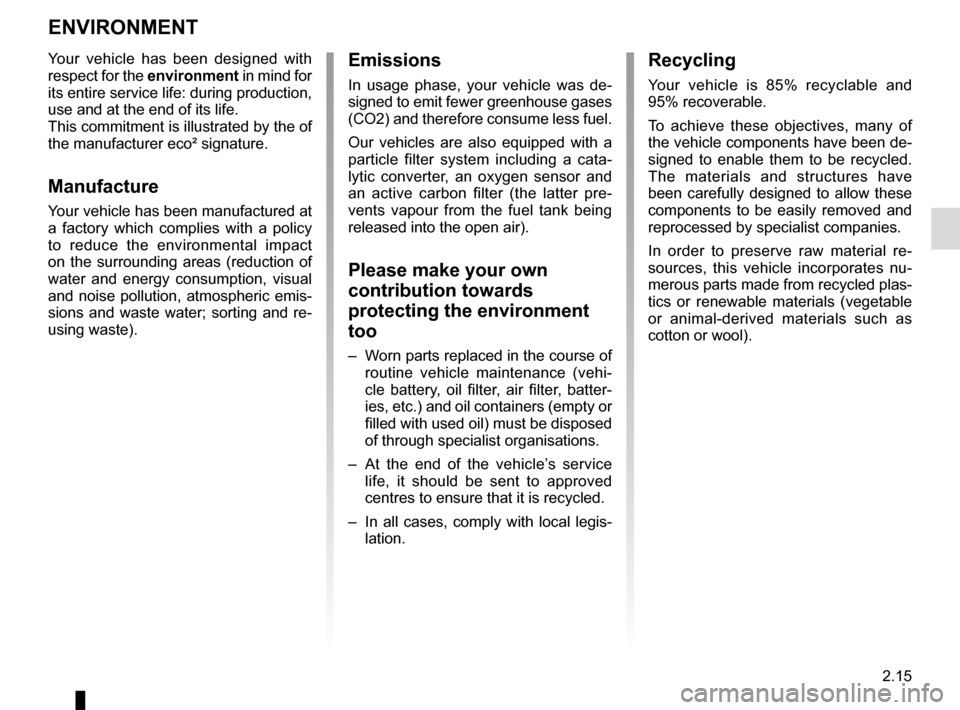
2.15
ENVIRONMENT
Your vehicle has been designed with
respect for the environment in mind for
its entire service life: during production,
use and at the end of its life.
This commitment is illustrated by the of
the manufacturer eco² signature.
Manufacture
Your vehicle has been manufactured at
a factory which complies with a policy
to reduce the environmental impact
on the surrounding areas (reduction of
water and energy consumption, visual
and noise pollution, atmospheric emis-
sions and waste water; sorting and re-
using waste).
Emissions
In usage phase, your vehicle was de-
signed to emit fewer greenhouse gases
(CO2) and therefore consume less fuel.
Our vehicles are also equipped with a
particle filter system including a cata-
lytic converter, an oxygen sensor and
an active carbon filter (the latter pre-
vents vapour from the fuel tank being
released into the open air).
Please make your own
contribution towards
protecting the environment
too
– Worn parts replaced in the course of routine vehicle maintenance (vehi-
cle battery, oil filter, air filter, batter-
ies, etc.) and oil containers (empty or
filled with used oil) must be disposed
of through specialist organisations.
– At the end of the vehicle’s service life, it should be sent to approved
centres to ensure that it is recycled.
– In all cases, comply with local legis- lation.
Recycling
Your vehicle is 85% recyclable and
95% recoverable.
To achieve these objectives, many of
the vehicle components have been de-
signed to enable them to be recycled.
The materials and structures have
been carefully designed to allow these
components to be easily removed and
reprocessed by specialist companies.
In order to preserve raw material re-
sources, this vehicle incorporates nu-
merous parts made from recycled plas-
tics or renewable materials (vegetable
or animal-derived materials such as
cotton or wool).
Page 95 of 228
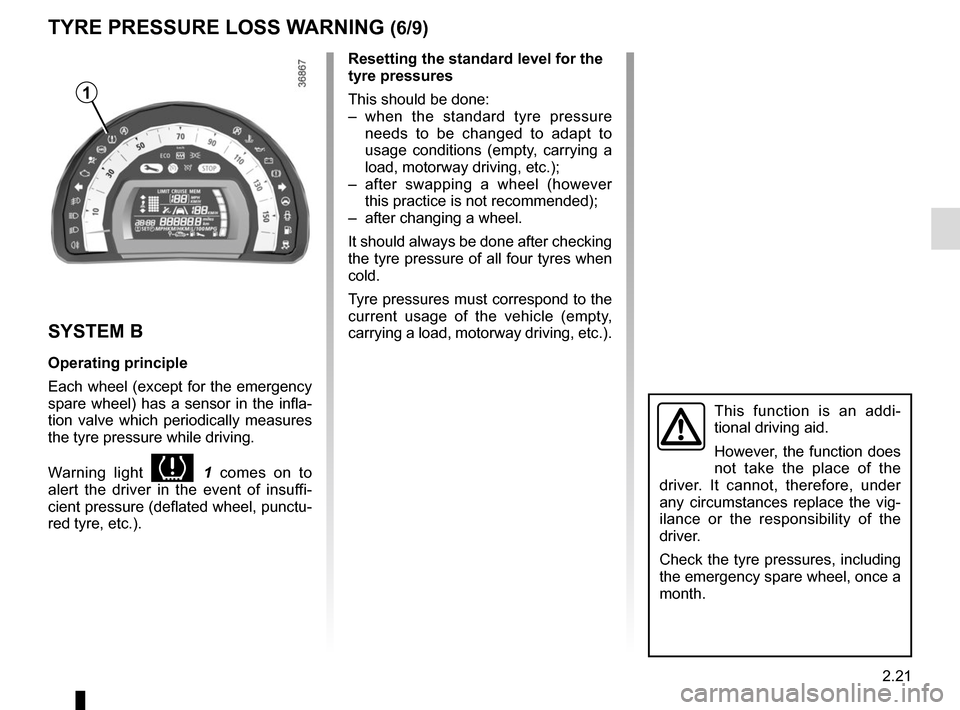
2.21
TYRE PRESSURE LOSS WARNING (6/9)
SYSTEM B
Operating principle
Each wheel (except for the emergency
spare wheel) has a sensor in the infla-
tion valve which periodically measures
the tyre pressure while driving.
Warning light
1 comes on to
alert the driver in the event of insuffi-
cient pressure (deflated wheel, punctu-
red tyre, etc.).
1
Resetting the standard level for the
tyre pressures
This should be done:
– when the standard tyre pressure needs to be changed to adapt to
usage conditions (empty, carrying a
load, motorway driving, etc.);
– after swapping a wheel (however this practice is not recommended);
– after changing a wheel.
It should always be done after checking
the tyre pressure of all four tyres when
cold.
Tyre pressures must correspond to the
current usage of the vehicle (empty,
carrying a load, motorway driving, etc.).
This function is an addi-
tional driving aid.
However, the function does
not take the place of the
driver. It cannot, therefore, under
any circumstances replace the vig-
ilance or the responsibility of the
driver.
Check the tyre pressures, including
the emergency spare wheel, once a
month.
Page 97 of 228
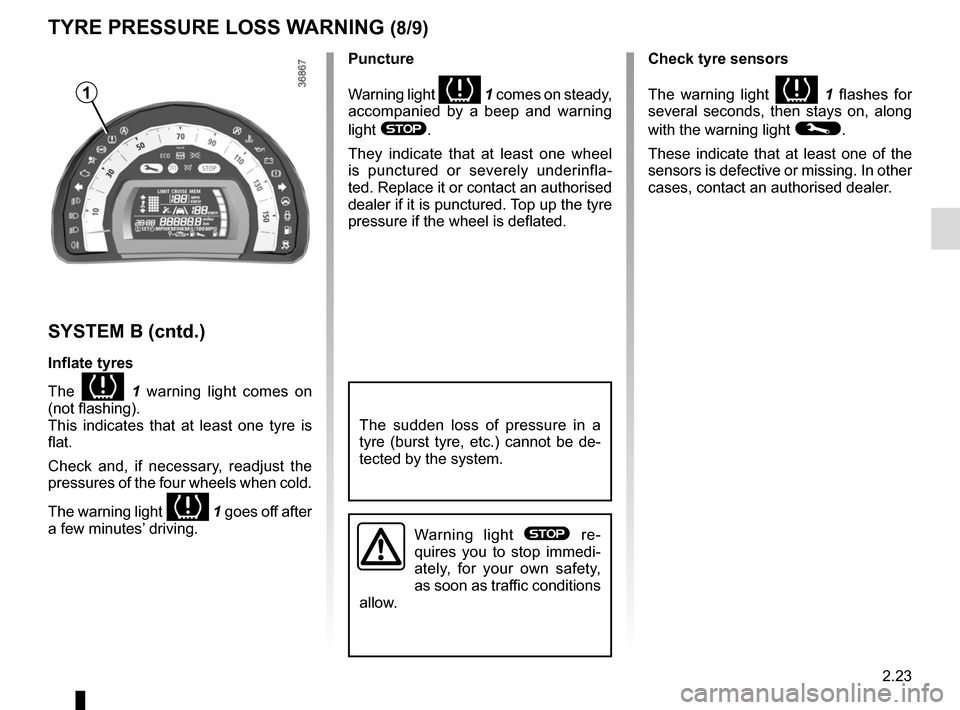
2.23
TYRE PRESSURE LOSS WARNING (8/9)
SYSTEM B (cntd.)
Inflate tyres
The
1 warning light comes on
(not flashing).
This indicates that at least one tyre is
flat.
Check and, if necessary, readjust the
pressures of the four wheels when cold.
The warning light
1 goes off after
a few minutes’ driving.
The sudden loss of pressure in a
tyre (burst tyre, etc.) cannot be de-
tected by the system.
Puncture
Warning light
1 comes on steady,
accompanied by a beep and warning
light
®.
They indicate that at least one wheel
is punctured or severely underinfla-
ted. Replace it or contact an authorised
dealer if it is punctured. Top up the tyre
pressure if the wheel is deflated.
Warning light ® re-
quires you to stop immedi-
ately, for your own safety,
as soon as traffic conditions
allow.
Check tyre sensors
The warning light
1 flashes for
several seconds, then stays on, along
with the warning light
©.
These indicate that at least one of the
sensors is defective or missing. In other
cases, contact an authorised dealer.
1
Page 98 of 228
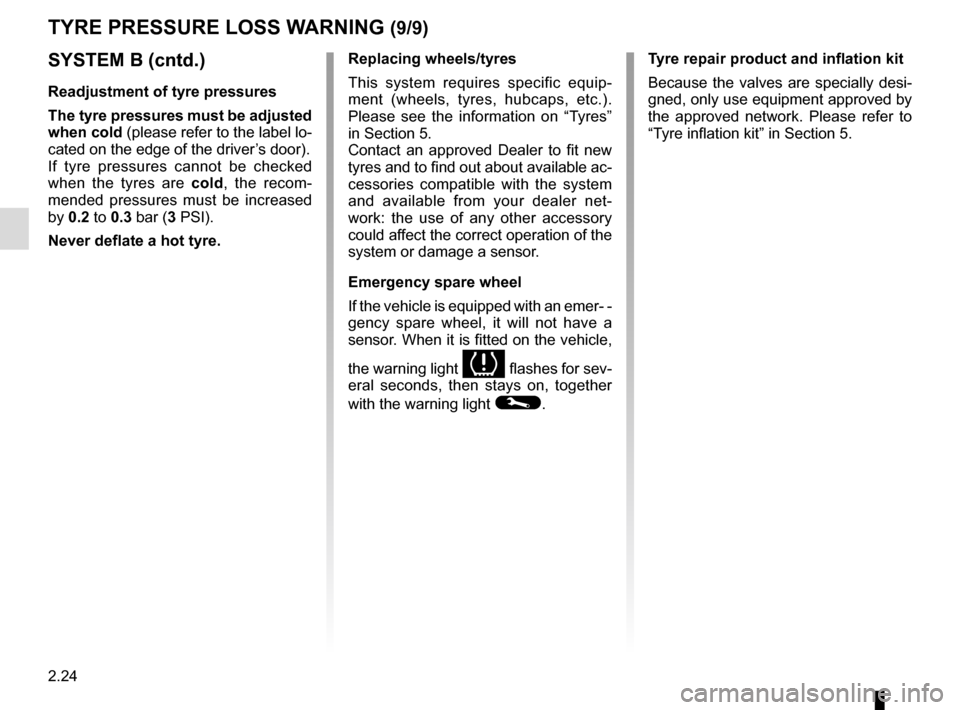
2.24
SYSTEM B (cntd.)
Readjustment of tyre pressures
The tyre pressures must be adjusted
when cold (please refer to the label lo-
cated on the edge of the driver’s door).
If tyre pressures cannot be checked
when the tyres are cold, the recom-
mended pressures must be increased
by 0.2 to 0.3 bar (3 PSI).
Never deflate a hot tyre.
TYRE PRESSURE LOSS WARNING (9/9)
Replacing wheels/tyres
This system requires specific equip-
ment (wheels, tyres, hubcaps, etc.).
Please see the information on “Tyres”
in Section 5.
Contact an approved Dealer to fit new
tyres and to find out about available ac-
cessories compatible with the system
and available from your dealer net-
work: the use of any other accessory
could affect the correct operation of the
system or damage a sensor.
Emergency spare wheel
If the vehicle is equipped with an emer- -
gency spare wheel, it will not have a
sensor. When it is fitted on the vehicle,
the warning light
flashes for sev-
eral seconds, then stays on, together
with the warning light
©.
Tyre repair product and inflation kit
Because the valves are specially desi-
gned, only use equipment approved by
the approved network. Please refer to
“Tyre inflation kit” in Section 5.
Page 100 of 228
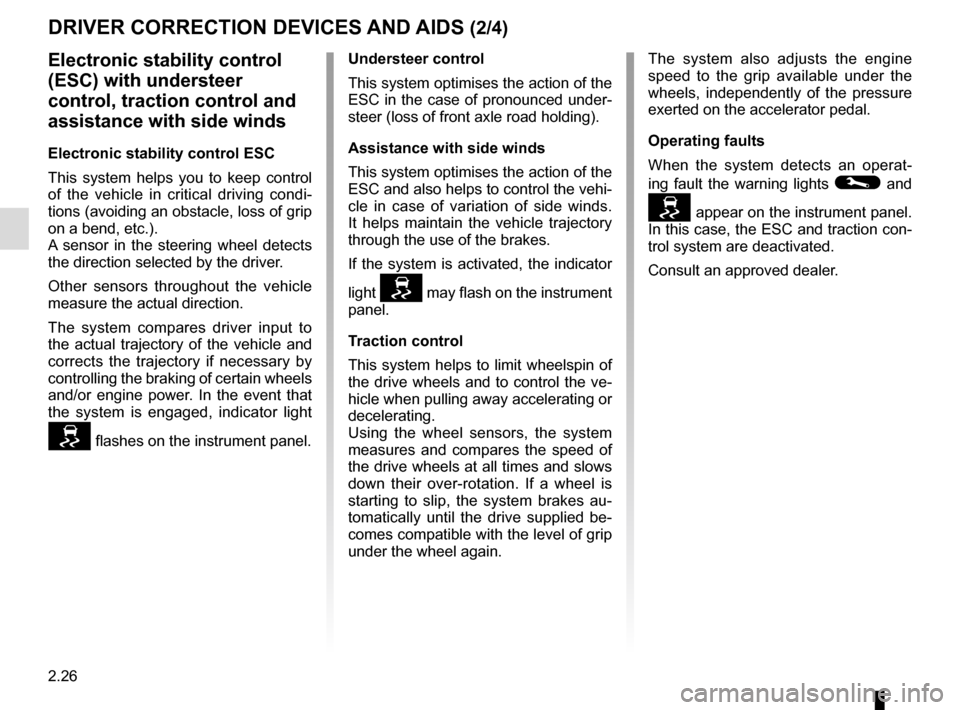
2.26
Electronic stability control
(ESC) with understeer
control, traction control and
assistance with side winds
Electronic stability control ESC
This system helps you to keep control
of the vehicle in critical driving condi-
tions (avoiding an obstacle, loss of grip
on a bend, etc.).
A sensor in the steering wheel detects
the direction selected by the driver.
Other sensors throughout the vehicle
measure the actual direction.
The system compares driver input to
the actual trajectory of the vehicle and
corrects the trajectory if necessary by
controlling the braking of certain wheels
and/or engine power. In the event that
the system is engaged, indicator light
flashes on the instrument panel.
DRIVER CORRECTION DEVICES AND AIDS (2/4)
Understeer control
This system optimises the action of the
ESC in the case of pronounced under-
steer (loss of front axle road holding).
Assistance with side winds
This system optimises the action of the
ESC and also helps to control the vehi-
cle in case of variation of side winds.
It helps maintain the vehicle trajectory
through the use of the brakes.
If the system is activated, the indicator
light
may flash on the instrument
panel.
Traction control
This system helps to limit wheelspin of
the drive wheels and to control the ve-
hicle when pulling away accelerating or
decelerating.
Using the wheel sensors, the system
measures and compares the speed of
the drive wheels at all times and slows
down their over-rotation. If a wheel is
starting to slip, the system brakes au-
tomatically until the drive supplied be-
comes compatible with the level of grip
under the wheel again. The system also adjusts the engine
speed to the grip available under the
wheels, independently of the pressure
exerted on the accelerator pedal.
Operating faults
When the system detects an operat-
ing fault the warning lights
© and
appear on the instrument panel.
In this case, the ESC and traction con-
trol system are deactivated.
Consult an approved dealer.
Page 185 of 228
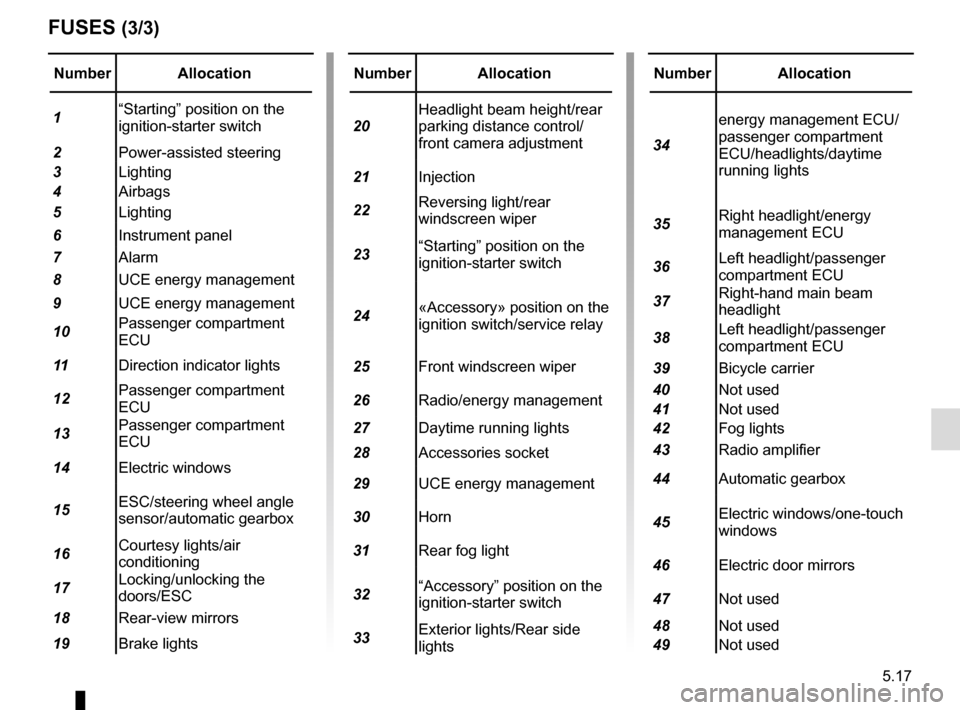
5.17
Number Allocation
1 “Starting” position on the
ignition-starter switch
2 Power-assisted steering
3 Lighting
4 Airbags
5 Lighting
6 Instrument panel
7 Alarm
8 UCE energy management
9 UCE energy management
10 Passenger compartment
ECU
11 Direction indicator lights
12 Passenger compartment
ECU
13 Passenger compartment
ECU
14 Electric windows
15 ESC/steering wheel angle
sensor/automatic gearbox
16 Courtesy lights/air
conditioning
17 Locking/unlocking the
doors/ESC
18 Rear-view mirrors
19 Brake lights
FUSES (3/3)
Number Allocation
20 Headlight beam height/rear
parking distance control/
front camera adjustment
21 Injection
22 Reversing light/rear
windscreen wiper
23 “Starting” position on the
ignition-starter switch
24 «Accessory» position on the
ignition switch/service relay
25 Front windscreen wiper
26 Radio/energy management
27 Daytime running lights
28 Accessories socket
29 UCE energy management
30 Horn
31 Rear fog light
32 “Accessory” position on the
ignition-starter switch
33 Exterior lights/Rear side
lightsNumber Allocation
34 energy management ECU/
passenger compartment
ECU/headlights/daytime
running lights
35 Right headlight/energy
management ECU
36 Left headlight/passenger
compartment ECU
37 Right-hand main beam
headlight
38 Left headlight/passenger
compartment ECU
39 Bicycle carrier
40 Not used
41 Not used
42 Fog lights
43 Radio amplifier
44 Automatic gearbox
45 Electric windows/one-touch
windows
46 Electric door mirrors
47 Not used
48 Not used
49 Not used
Page 201 of 228
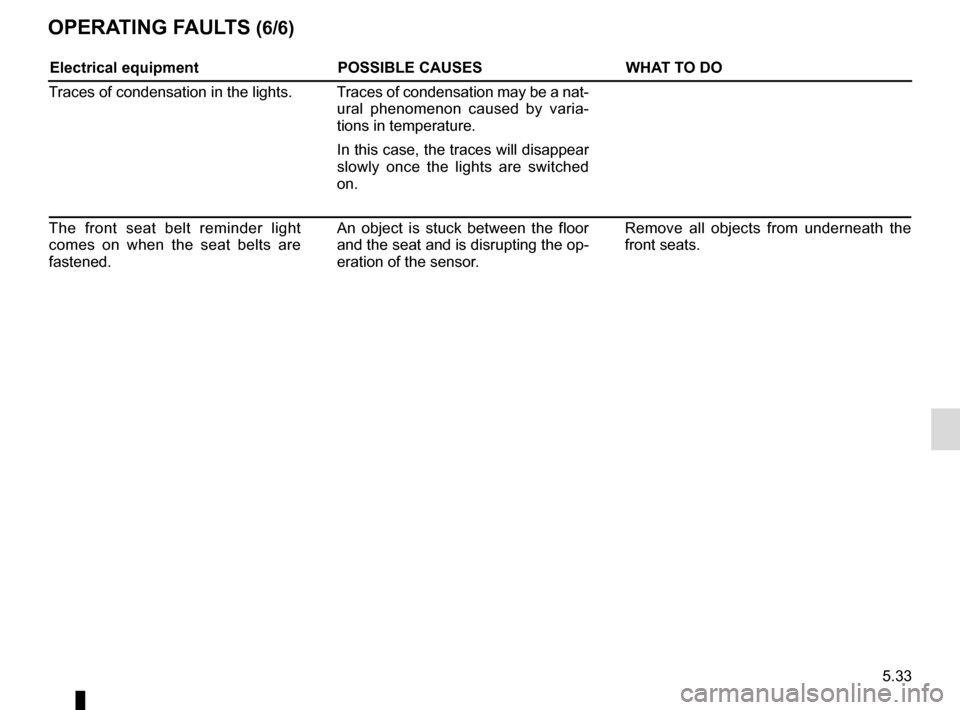
5.33
Electrical equipmentPOSSIBLE CAUSESWHAT TO DO
Traces of condensation in the lights. Traces of condensation may be a nat- ural phenomenon caused by varia-
tions in temperature.
In this case, the traces will disappear
slowly once the lights are switched
on.
The front seat belt reminder light
comes on when the seat belts are
fastened. An object is stuck between the floor
and the seat and is disrupting the op-
eration of the sensor. Remove all objects from underneath the
front seats.
OPERATING FAULTS (6/6)
Page 224 of 228
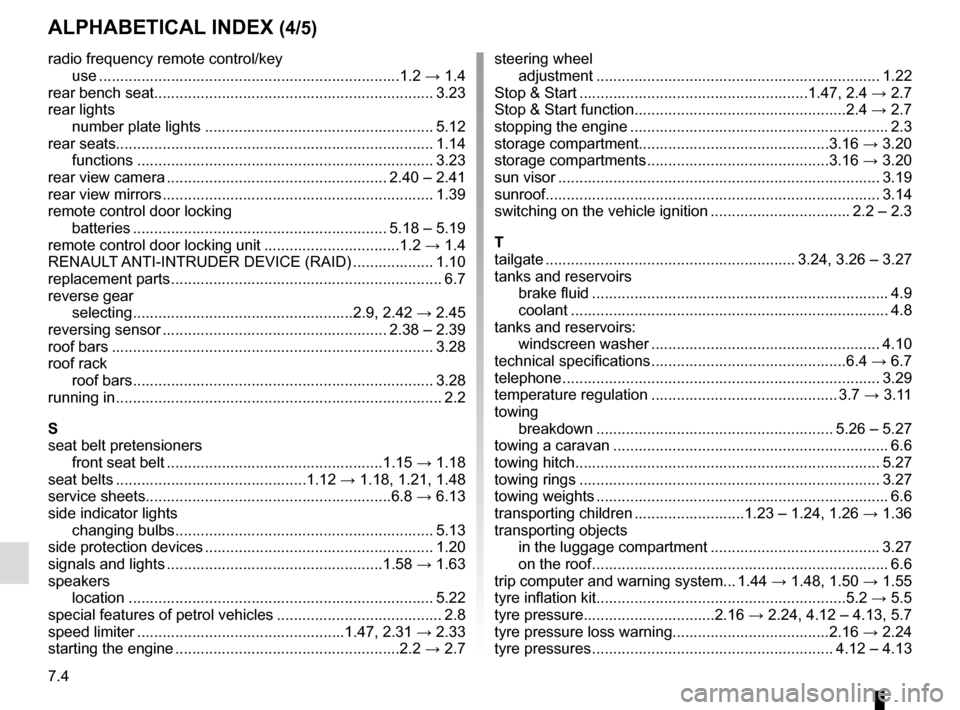
7.4
ALPHABETICAL INDEX (4/5)
radio frequency remote control/keyuse ....................................................................\
...1.2 → 1.4
rear bench seat.................................................................. 3.23
rear lights number plate lights ...................................................... 5.12
rear seats........................................................................\
... 1.14 functions ..............................................................\
........ 3.23
rear view camera .................................................... 2.40 – 2.41
rear view mirrors ................................................................ 1.39
remote control door locking batteries ............................................................ 5.18 – 5.19
remote control door locking unit ................................1.2 → 1.4
RENAULT ANTI-INTRUDER DEVICE (RAID) ................... 1.10
replacement parts ................................................................ 6.7
reverse gear selecting ....................................................2.9, 2.42 → 2.45
reversing sensor ..................................................... 2.38 – 2.39
roof bars ........................................................................\
.... 3.28
roof rack roof bars ....................................................................... 3.28
running in ........................................................................\
..... 2.2
S
seat belt pretensioners front seat belt ...................................................1.15 → 1.18
seat belts .............................................1.12 → 1.18, 1.21, 1.48
service sheets..........................................................6.8 → 6.13
side indicator lights changing bulbs ............................................................. 5.13
side protection devices ...................................................... 1.20
signals and lights ...................................................1.58 → 1.63
speakers location ...............................................................\
......... 5.22
special features of petrol vehicles ....................................... 2.8
speed limiter .................................................1.47, 2.31 → 2.33
starting the engine .....................................................2.2 → 2.7steering wheel
adjustment .............................................................\
...... 1.22
Stop & Start ......................................................1.47, 2.4 → 2.7
Stop & Start function..................................................2.4 → 2.7
stopping the engine ............................................................. 2.3
storage compartment.............................................3.16 → 3.20
storage compartments ...........................................3.16 → 3.20
sun visor ........................................................................\
.... 3.19
sunroof........................................................................\
....... 3.14
switching on the vehicle ignition ................................. 2.2 – 2.3
T
tailgate ........................................................... 3.24, 3.26 – 3.27
tanks and reservoirs brake fluid ...................................................................... 4.9
coolant ................................................................\
........... 4.8
tanks and reservoirs: windscreen washer ...................................................... 4.10
technical specifications ..............................................6.4 → 6.7
telephone ..............................................................\
............. 3.29
temperature regulation ............................................ 3.7 → 3.11
towing breakdown ........................................................ 5.26 – 5.27
towing a caravan ................................................................. 6.6
towing hitch........................................................................\
5.27
towing rings ....................................................................... 3.27
towing weights ..................................................................... 6.6
transporting children ..........................1.23 – 1.24, 1.26 → 1.36
transporting objects in the luggage compartment ........................................ 3.27
on the roof ...................................................................... 6.6
trip computer and warning system... 1.44 → 1.48, 1.50 → 1.55
tyre inflation kit...........................................................5.2 → 5.5
tyre pressure...............................2.16 → 2.24, 4.12 – 4.13, 5.7
tyre pressure loss warning.....................................2.16 → 2.24
tyre pressures ......................................................... 4.12 – 4.13